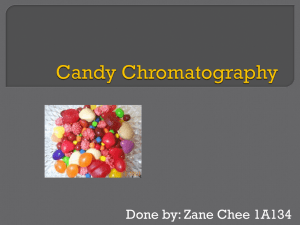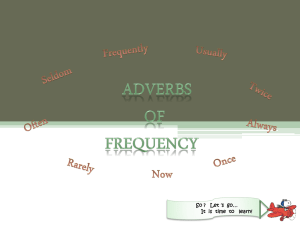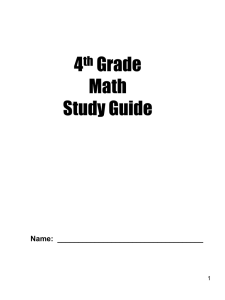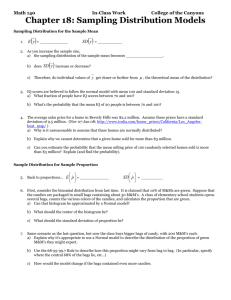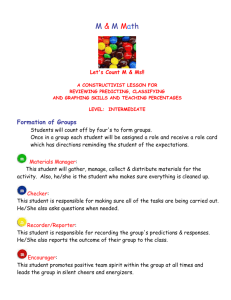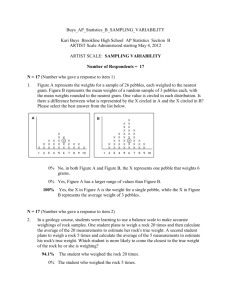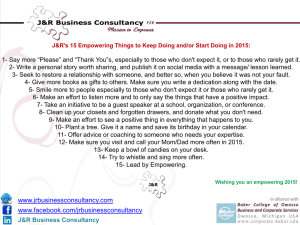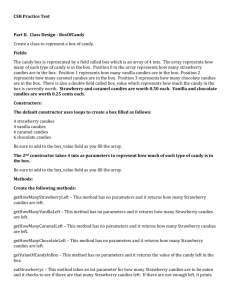Enacting and Solving Equations
advertisement
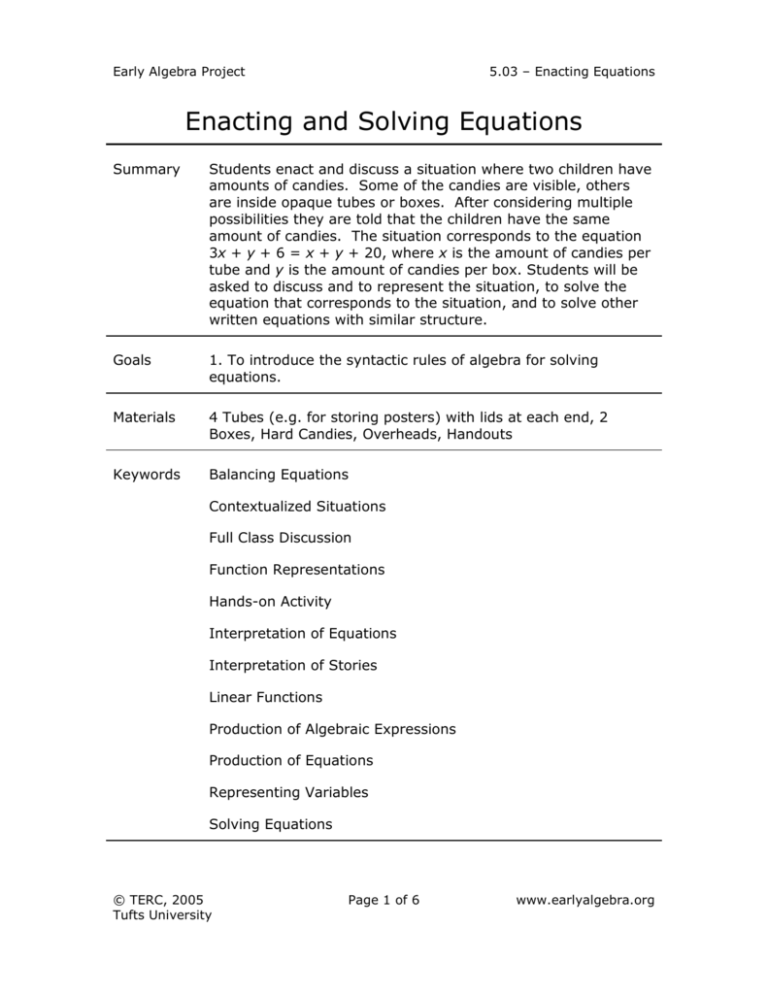
Early Algebra Project 5.03 – Enacting Equations Enacting and Solving Equations Summary Students enact and discuss a situation where two children have amounts of candies. Some of the candies are visible, others are inside opaque tubes or boxes. After considering multiple possibilities they are told that the children have the same amount of candies. The situation corresponds to the equation 3x + y + 6 = x + y + 20, where x is the amount of candies per tube and y is the amount of candies per box. Students will be asked to discuss and to represent the situation, to solve the equation that corresponds to the situation, and to solve other written equations with similar structure. Goals 1. To introduce the syntactic rules of algebra for solving equations. Materials 4 Tubes (e.g. for storing posters) with lids at each end, 2 Boxes, Hard Candies, Overheads, Handouts Keywords Balancing Equations Contextualized Situations Full Class Discussion Function Representations Hands-on Activity Interpretation of Equations Interpretation of Stories Linear Functions Production of Algebraic Expressions Production of Equations Representing Variables Solving Equations © TERC, 2005 Tufts University Page 1 of 6 www.earlyalgebra.org Early Algebra Project 5.03 – Enacting Equations Activity Plan: 1. Enacting the equation (whole class discussion: 15 minutes) Two volunteers come to the front of the class. Candies are distributed as follows. Student A Student B 3 tubes 1 tube 1 box 1 box 6 single candies 20 single candies Clarify that: Each box contains the same amount of candies. Each tube holds the same amount of candies (but not, necessarily, the same as in boxes ). Discuss the situation and ask the students to consider multiple possible values for the amount of candies that could be in the tubes and in the boxes, After discussion, state that: Each student has the same total number of candies. 2. Representing the situation (individual work: 15 minutes) Distribute Handout 1 (Page 1) and ask the students to show what they know, and to try to figure out what they can say about how many candies are in each box and in each tube. 3. Discussing children’s representations (whole class: 15 minutes) Collect the handouts and select a few representations and solutions to discuss. Write some of the children’s solutions on the board or on overheads and discuss how each one represents the situation (or not). Go back to the tubes, boxes, and candies display. Discuss how many candies could be in each box and in each tube. Ask the children what will happen if both students eat all the candies in their boxes. Explore the idea that if equal boxes are eliminated from both sides of the equation, the two children still have equal amounts. Eliminate the box from each student and ask: are the two children’s amounts of candy still equal? © TERC, 2005 Tufts University Page 2 of 6 www.earlyalgebra.org Early Algebra Project 5.03 – Enacting Equations Propose to eliminate one tube from each child. Discuss whether they still have equal amounts of candies. Ask them to compute how many candies are in each tube. 4. Solving the written equation (whole class: 15 minutes) If the children did not use letters to represent the amounts in the boxes and tubes, propose to do so. Write the equation on the board: 3x + y + 6 = x + y + 20 Working with the written equation, ask a few individual children to try to solve the equation on the board. Getting input from the children, repeat the process of eliminating equal amounts from each side of the equality. Make sure the elimination of equal amounts from each side is represented as subtraction. If necessary, discuss that 3x is the same as x + x + x and that, when we eliminate one x from 3x, we get 2x. Ask children to explain why they are sure about the number of candies in each tube. If you have time, discuss how many candies are in each box, and how we can’t know the answer with the information that we have. 5. Solving written equations (individual work and whole class: 15 minutes) Distribute handout 2 (Page 2) and ask the children to solve the equation 4x + y + 10 = x + y + 25, registering in writing each step towards the solution. Discuss their solutions. If you have time, ask the students to consider the equation 5x + y + 10 = x + y + 26. 6. Homework (Page 3) Students will solve a story problem using what they have learned in this and in the previous lesson. © TERC, 2005 Tufts University Page 3 of 6 www.earlyalgebra.org Early Algebra Project 5.03 – Enacting Equations Overhead and Handout: The Problem (Page 1) Name: _________________________________ Date: ____________ Student A has 3 tubes, 1 box, and 6 single candies. Student B has 1 tube, 1 box, and 20 single candies Each box contains the same amount of candies as each other box. Each tube contains the same amount of candies as each other tube. Student A has the same total number of candies as student B. 1. Show how many candies Student A has. 2. Show how many candies Student B has. 3. Show that the two students have the same amount of candies. 4. Find out how many candies are in each tube, showing how you found your answer. 5. Can you figure out how many candies are in each box? Explain. © TERC, 2005 Tufts University Page 4 of 6 www.earlyalgebra.org Early Algebra Project 5.03 – Enacting Equations Overhead and Handout: Solving an Equation (Page 2) Name: _________________________________ Date: ____________ Find out the value of x in the following equation, showing all the steps to find your answer: 4x + y + 10 = x + y + 25 What are the values of y in the equation you just solved? © TERC, 2005 Tufts University Page 5 of 6 www.earlyalgebra.org Early Algebra Project 5.03 – Enacting Equations Overhead and Homework (Page 3) Name: _________________________________ Date: ____________ Jessica and Kelly went apple picking so that they could make some pies. Jessica picked 7 red apples and some green apples. Kelly picked 2 red apples, the same number of green apples as Jessica, and some yellow apples. Represent Jessica’s apples at the end of the day Represent Kelly’s apples at the end of the day We know that both of them collected the same total amount of apples. Write an equation that shows Jessica and Kelly having the same amount of apples at the end of the day. Then solve the equation to show how many yellow apples Kelly had at the end of the day? How many green apples did Kelly collect? How many green apples did Jessica collect? © TERC, 2005 Tufts University Page 6 of 6 www.earlyalgebra.org
